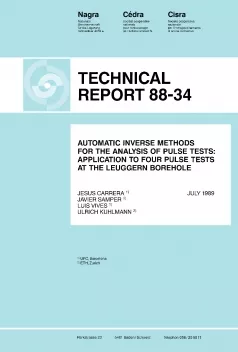
Technical Report NTB 88-34
Automatic inverse methods for the analysis of pulse tests:Application to four pulse tests at the Leuggern borehole
Four pulse tests performed for Nagra at the Leuggern borehole were analyzed using automatic test sequence matching techniques. Severe identifiability problems were unveiled during the process. Because of these problems, the identifiability of aquifer parameters (hydraulic conductivity, storativity and skin conductivity) from pulse tests similar to those performed in the Leuggern borehole was studied in two synthetic examples. The first of these had a positive skin effect and the second had a negative skin effect. These synthetic examples showed that, for the test conditions at the Leuggern borehole, estimating formation hydraulic conductivity may be nearly impossible for the cases of positive and negative skin factors. In addition, identifiability appears to be quite sensitive to the values of the parameters and to other factors such as skin thickness. Nevertheless, largely because of the manner in which the tests were conducted (i.e. relatively long injection time and performance of both injection and withdrawal), identifiability of the actual tests was much better than suggested by the synthetic examples. Only one of the four tests was nearly non-identifiable. In all, the match between measured and computed aquifer responses was excellent for all the tests, and formation hydraulic conductivities were estimated within a relatively narrow uncertainty interval.
